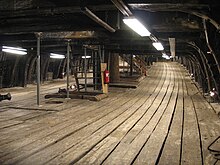Gun deck


The term gun deck used to refer to a deck aboard a ship that was primarily used for the mounting of cannon to be fired in broadsides. However, on many smaller vessels such as frigates and unrated vessels, the upper deck, forecastle and quarterdeck bore all of the cannons but were not referred to as the gun deck. The completely covered level under the upper deck was, however, still called the gun deck although it had no guns at all.[1]
On board marine seismic survey vessels, the lowest deck on the ship is normally referred to as the gun deck. This deck carries the seismic source arrays, consisting of air guns arranged in clusters.[2][3]
Slang
The term "gun deck" is also navy slang for fabricating or falsifying something. Some say the origin of the term dates to the practice of painting images of cannon ports on the side of a ship to make it appear to have more guns than it actually did, and thereby convincing any adversaries that they were outgunned, forgoing engagement. A more plausible explanation relates to midshipmen retiring to the gun deck to complete their celestial navigation assignments of computing the ship's position three times daily following morning star sights, noon sun line, and evening star sights. While some midshipmen might be conscientious about computing positions from new observations, others were reputed to extrapolate and back calculate observation data from dead reckoning courses and speeds since earlier observations; and the actual computations performed on the gun deck were suspect.
This term is now used to indicate the falsification of documentation in order to avoid actually doing the work or make present conditions seem otherwise acceptable.[4]
See also
References
- ^ Knight, Austin M. Modern Seamanship Tenth Edition (1941) D. Van Nostrand Company p.798
- ^ http://www.ogp.org.uk/pubs/448.pdf
- ^ "Archived copy". Archived from the original on 2014-11-09. Retrieved 2012-01-25.
{{cite web}}: Unknown parameter|deadurl=ignored (|url-status=suggested) (help)CS1 maint: archived copy as title (link) - ^ "Origin of Navy Terminology". United States Navy. Retrieved 2011-02-04.
